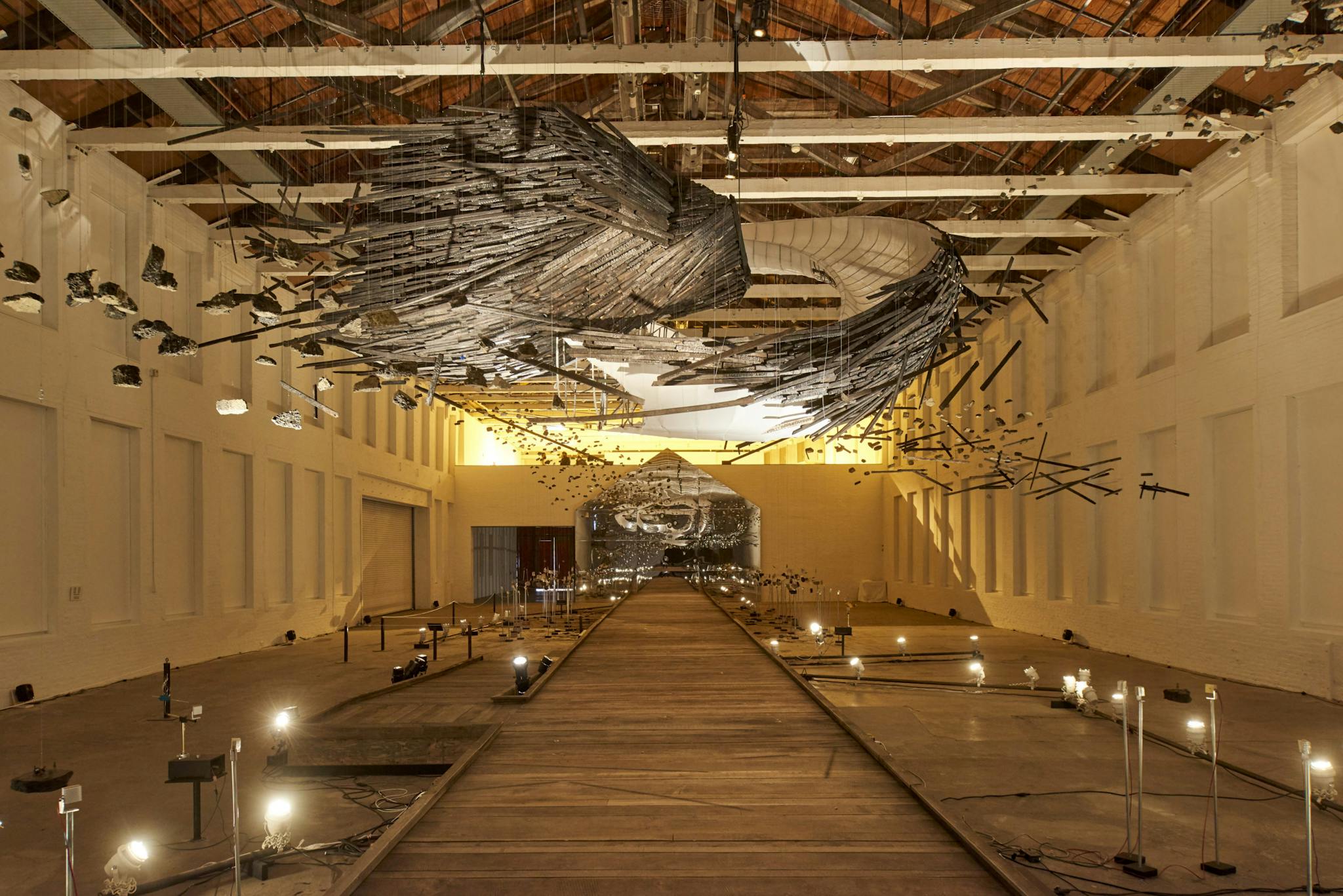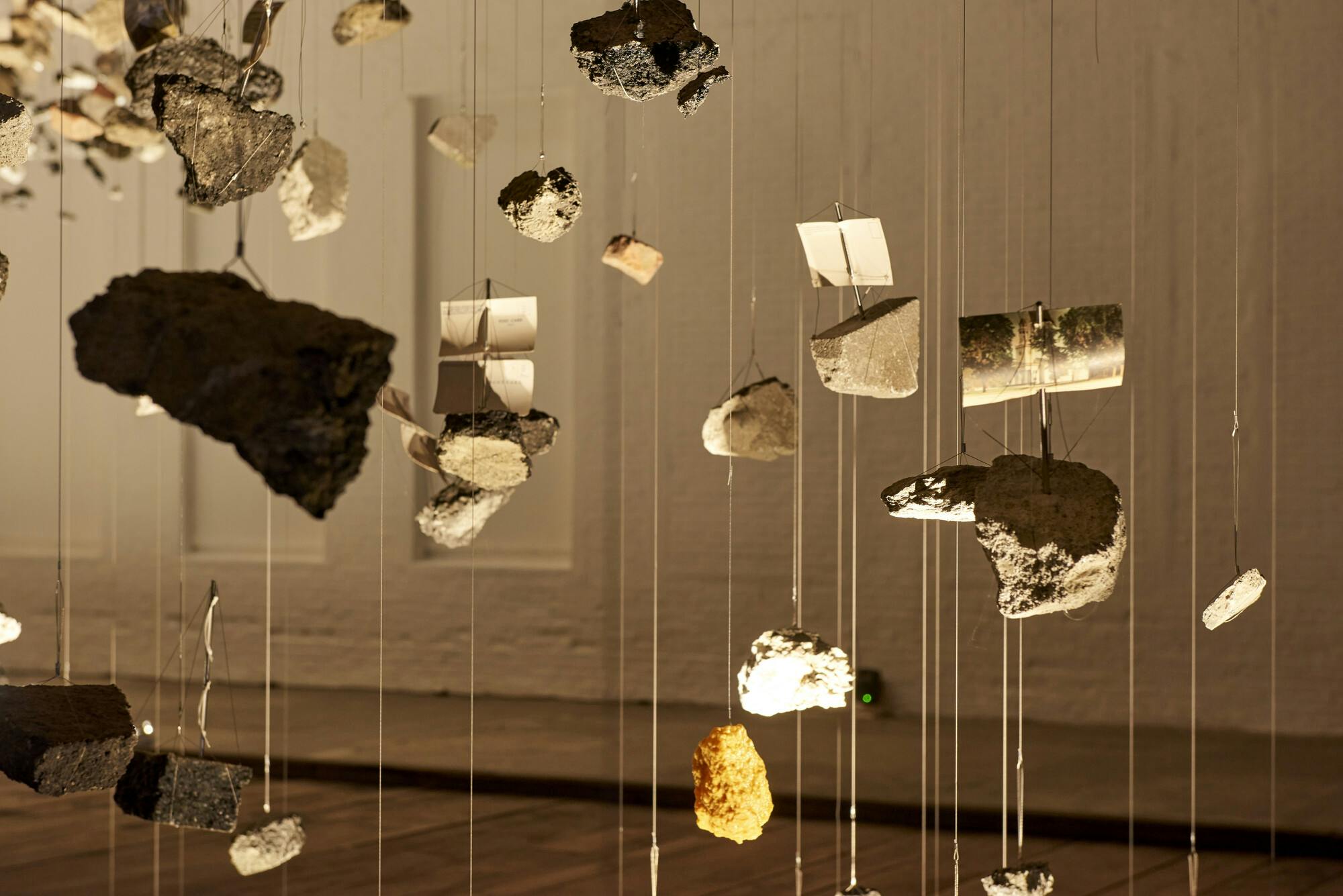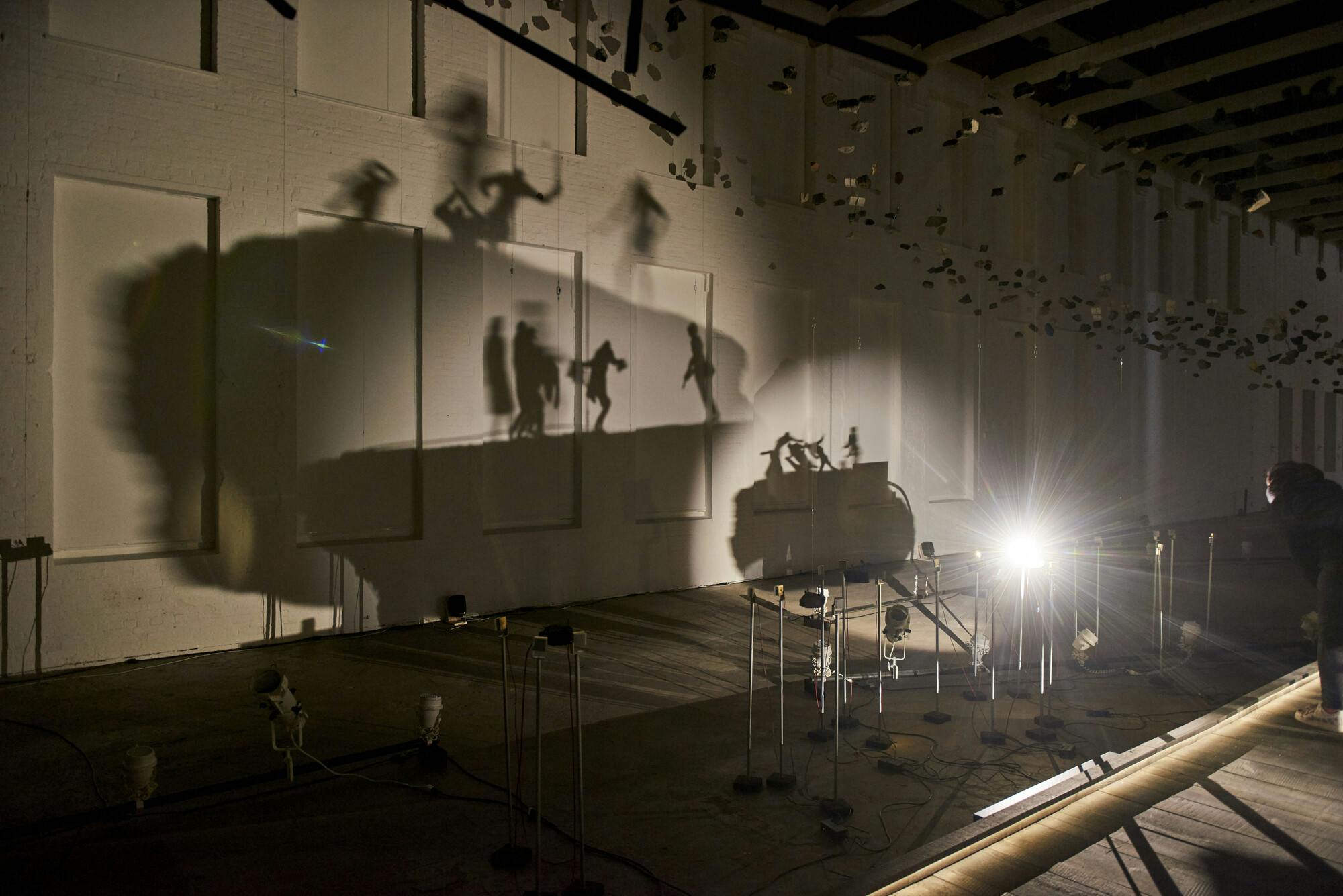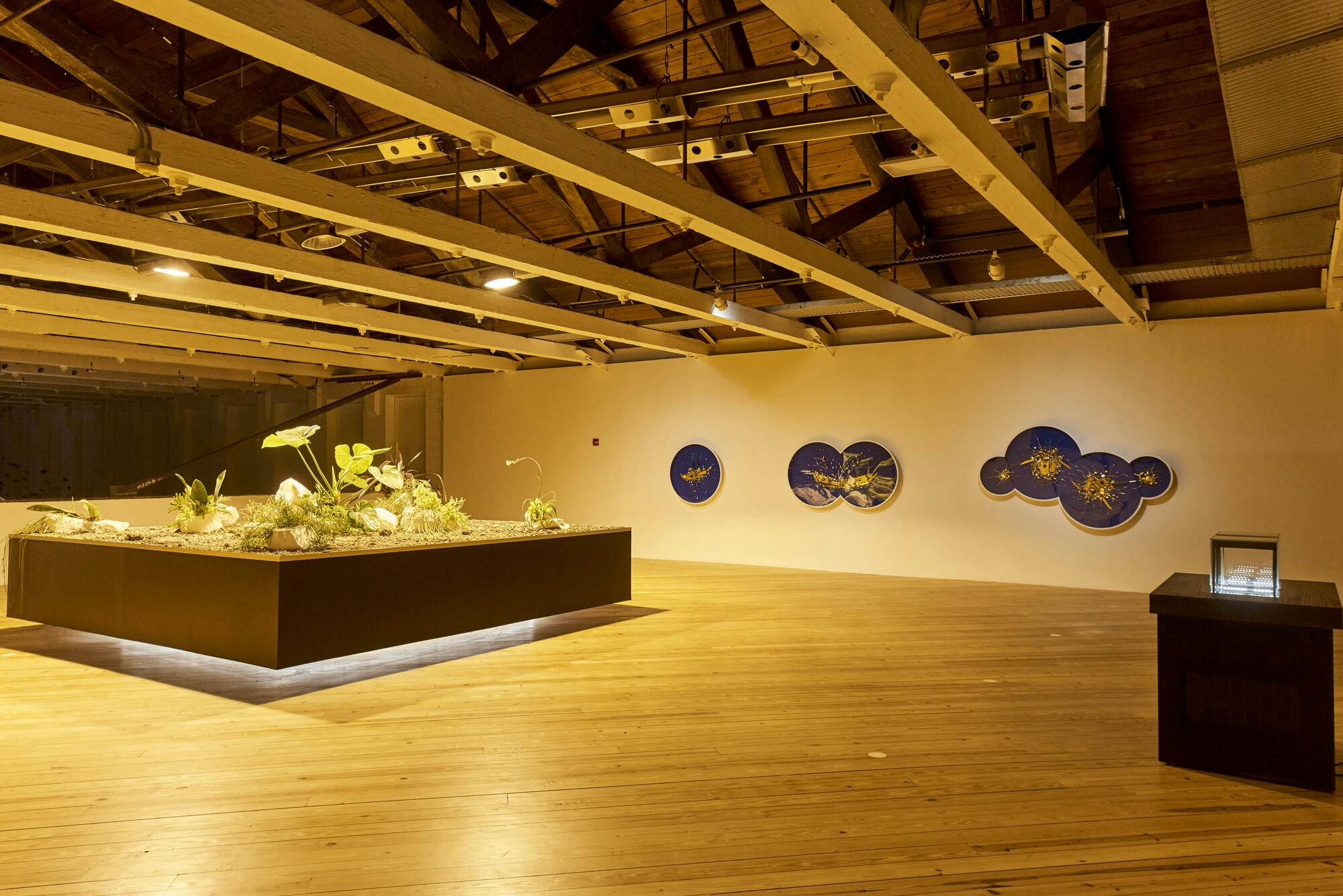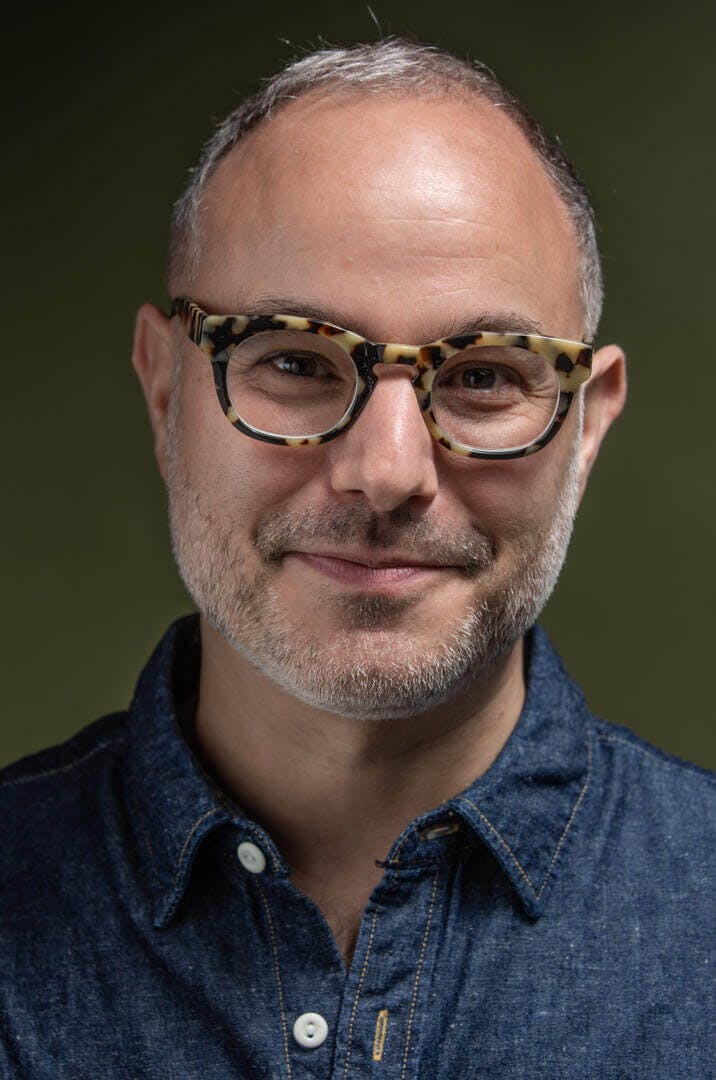Los Angeles artist Glenn Kaino’s massive exhibition “In the Light of a Shadow” suggests the power of a network of voices. Two side-by-side billboards outside MASS MoCA name autonomous zones, one for Derry in North Ireland and one for Selma, Alabama. In Selma, on Bloody Sunday, March 7, 1965, Alabama state troopers attacked Black demonstrators advocating for fundamental human rights and the right to vote. In Derry, on Bloody Sunday, January 30, 1972, British paratroopers attacked Irish nationalist demonstrators also seeking basic human rights and the right to vote. One of Kaino’s 2021 billboards declares, “YOU ARE NOW ENTERING FREE DERRY,” the other, “YOU ARE NOW ENTERING FREE SELMA.”
Looking at these billboards, you can be in two places at once, straddling time and the Atlantic Ocean, contemplating justice, freedom, and the impact of the ongoing global struggle for human rights. Anger over Derry’s Bloody Sunday turned some citizens away from nonviolence and fueled recruitment for the Provisional Irish Republican Army, the IRA, who wanted the British out of Northern Ireland by any means necessary. Bloody Sunday in Selma convinced US President Lyndon Johnson to send a voting rights act to Congress, but there was anger in Selma too. At a speech following Bloody Sunday, Martin Luther King Jr. encapsulated the mood, asking, “How long will justice be crucified, and truth bear it?”
Inside the museum, Kaino’s exhibition spans three warehouse galleries and two floors. The exhibition is characteristic of Kaino, who often collaborates and employs documentary and intricate large-scale sculpture to address transformation and social change. The crux of the exhibition is an immersive multimedia installation that plays every hour—part concert, part shadow play. Museum guards welcome you to the installation, encourage you to wait to enter until it starts, and help direct your experience. The guards are like marshals who try to ensure that an official march goes smoothly, that marchers move at a uniform pace and stay within permitted boundaries.
An enveloping soundtrack for the installation is industrial post-punk—haunting, muscled, martial electronic music scored by Dave Sitek from US rock band TV on the Radio. You can almost hear projectiles hitting riot shields and the thud of nightsticks. You walk down a two-hundred-foot-long boardwalk under hundreds of suspended stones, bricks, pieces of cinder block, debris, and a snake-like boat, then face a mirrored version of the wall where the Irish nationalists in Derry wrote, “YOU ARE NOW ENTERING FREE DERRY.” You see yourself projected in shadow onto the gallery walls and in the Derry mirror wall. The whole space smells like wood. The physical scale, haunting theatricality, and historical scope of the installation make it feel like something akin to a highly produced war memorial or a dream where you are part of faraway events that may have happened before your time.
Voices slip into the installation soundtrack—the assassinated Queer politician and activist Harvey Milk, school shooting survivor and gun control advocate David Hogg. Miniature figurative sculptures perch on rocks coming up from the floor. Lit ingeniously by pre-programmed moving lights, these sculptures project tableaus of the Bloody Sundays and other iconic scenes in succession, an honor roll of activists: Ieshia Evans in 2016 facing down police at a Black Lives Matter protest in Baton Rouge, the Tiananmen Square Tank Man in 1989, Colin Kaepernick and teammates in 2016 taking a knee, and 1968 Olympic champion Tommie Smith holding up his fist in a Black Power salute.
Kaino also fitted some of the rocks with masts and postcard sails, so boat shadows float over the gallery walls as if transporting messages. Some of the masts have words cut out of them. On the wall, projected texts include “CLIMATE ACTION NOW” and “END DETENTION NOW.” Kaino reminds us that civil rights efforts influence each other despite their uniqueness and the substantial individual human cost. They extend and connect symbolically, rhetorically, intellectually, bodily, and heroically.
The museum copy explains that the snake boat overhead is Kaino’s allusion to the IRA’s assassination of Queen Elizabeth’s cousin Lord Mountbatten on his fishing boat in 1979. The snake boat chases its tail, seemingly in the process of destroying itself and perhaps pointing to the things that can go wrong in social movements or any group interactions really—the trouble with ego, partial victories, people who refuse to come to the table, burnout for the ones who always show up, and the cockeyed officials who float on regardless.
In referring to civil rights then and now, Kaino embraces an ever-growing vocabulary of protest. For example, the panel One Crisis at a Time (Ours to Eat, Brotherhood) (2020) on view in an antechamber at the start of the exhibition is about the size of a roadside sign. On the panel, scraps of burnt wood form a directional arrow. Kaino has carved a message into each piece of wood. After burning, mostly partial phrases remain—phrases like “NO MORE…” and “HEAR ME NOW?” Similar burnt wood scraps are also suspended near the snake boat. Kaino seems to want us to know that the language of protest is incendiary, scorched even, perhaps somewhat beleaguered, but still authoritative. Despite everywhere this rhetoric has traveled, the language remains available, ready for new breath. Protest chants heard at marches and rallies are often not new. Hopefully, they aren’t stolen or appropriated. Ideally, they’re shared, part of a conscious lineage from one protest to another.
Toward the end of the exhibition, in a gallery after Kaino’s immersive installation, a video puts Bloody Sundays together again and tells the story of Deon Jones, a friend of Kaino’s whom Los Angeles police nearly killed at a Black Lives Matter protest. For the video, Jones sings a beautiful rendition of Irish rock band U2’s 1983 protest ballad “Sunday Bloody Sunday,” much of it from inside a cage that Kaino built as an instrument, the bars tuned so that when struck with a mallet, they also play the song. In the video, we see Los Angeles, Selma, and Derry. We hear from John Lewis, who, with Hosea Williams, led the Selma march. Two years before Selma, Lewis spoke at the March on Washington. Already, he was tired. He asked, “How long can we be patient?”
Martin Luther King Jr.’s speech in Selma ended on a high note. He asked how long justice would be crucified, then launched into a rousing call-and-response provisioning hope. He asked, “How long?” and answered, “Not long.”
It might be easy to get sentimental in response to what is essentially a searching, optimistic, and carefully choreographed educationally minded exhibition. Upstairs, plants are growing out of rocks in the exhibition’s final gallery. We know these rocks. Like many people, they might have been stubborn and resistant. It wasn’t their job to grow plants, so they never did. But we know these plants too. They found a way, sprouting improbably, just where everyone thought it was impossible. They exemplify light from shadow, patience rewarded, change, hope, and unexpected new directions.
It doesn’t always feel like it, but sometimes we are making progress. Perhaps we are getting closer. Not to justice or freedom exactly. But maybe we are approaching just a little more light.
Glenn Kaino’s “In the Light of a Shadow” is on view through September 5, 2022, at MASS MoCA in North Adams, Massachusetts.
This article was originally published in Issue 07: Rooting in fall 2021.
